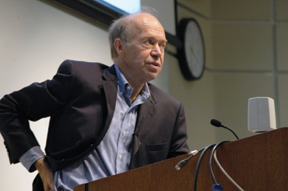NASA Researcher Delivers Sobering Plan to Address Global Warming

If Mother Earth ain’t happy, ain’t nobody happy. And, right now, Mother Earth is getting pretty steamed.
But it’s not the end of the world as we know it… yet.
Renowned NASA researcher James E. Hansen, Ph.D., was at the University of Kansas in September to deliver both the bad news and the good news about global warming and the state of the planet’s changing climate.
“We’re already at the point where it’s quite clear we are going to lose all the sea ice,” Hansen told the capacity crowd in Spahr Engineering Classroom at Eaton Hall. The sea ice will return, but only if people and governments take action now. “But there are irreversible tipping points,” he warned.
Hansen’s visit was arranged by the NSF Center for Remote Sensing of Ice Sheets, headquartered at KU. The center is developing new tools and technologies to measure changes in the earth’s ice sheets in order to better understand their role in climate change. Hansen, the director of the Goddard Institute for Space Studies at NASA, was one of the first voices in the 1980s to raise the issue of global warming and the disastrous effects it could have on humans, animals and plant life. Hansen maintains that the current state of global warming is largely due to the burning of fossil fuels and the increase of greenhouse gases in the atmosphere.
“We’ve already passed the dangerous point of CO2.” Current CO2 levels are measured at 385 ppm, he said, and by burning fossil fuels humans are pumping an additional 2 ppm into the atmosphere every year.

One of the more dramatic effects in coming years is going to be the melting of mountain glaciers, Hansen said. As a reservoir of fresh water for hundreds of millions of people, agriculture and animals, the value of glaciers is immeasurable.
“Those glaciers are melting back all over the planet. If you look at the rate they are melting back … within some decades we could lose most of that ice.”
Ice sheets in Greenland and Antarctica, the focus of research at CReSIS, also are at risk. Such ice sheets play an important feedback role in the earth’s climate system.
“We argue based on the earth’s history that if we want ice sheets to be stable and anything like their present size then we really should probably have CO2 in the neighborhood of 300 ppm. At any rate it’s less than 385. It’s going to be a much smaller ice sheet than what we have now.”
Armed with data-loaded charts, Hansen focused on the cause and effect of atmospheric CO2.
“The basis for what we say about global warming is climate models, but in fact the earth’s history is a much more valuable source of information on how much the system will respond to given change.” The high point of CO2 levels was roughly 65 million years ago, when continental drift shoved India into Eurasia to create the Himalayas, Hansen said. Naturally occurring releases through volcanoes and plate tectonics brought CO2 levels up to 1,000 ppm. “Ever since then the planet has been cooling off. By the time it had cooled down to the temperature at 34 million years ago, then ice and snow began to form on Antarctica.” At the start of the 20th century, CO2 was well under 300 ppm, but has since been rising. By the year 2100, GISS researchers predict atmospheric CO2 could be between 500 and 900 ppm.
“If we burn all the fossil fuels we’ll end up tripling the amount of CO2 in the atmosphere and the equilibrium response of the system would be a planet with no ice. It would take time to get there, but we would have started a process in a dynamical system that would then be out of our control and out of the control of our young people who are going to inherit this problem.”

For Hansen, the call to act is quite clear, and no less than the future of our species depends upon what humans choose to do right now. Although there are other human forces and greenhouse gases at play in global climate change, the long lifetime of CO2 makes controlling it crucial to any ongoing remedy. Earth’s natural systems absorb much of the CO2 in the atmosphere, he said, but the process is protracted, taking millennia.
“I argue that, at most, the target CO2 we should aim for is 350 ppm, and probably less than that, if we want to preserve the planet for this civilization,” Hansen said.
Hansen maintains the best approach to secure a future for coming generations and to avoid the extinction of animals is to decrease CO2 emissions from coal and substitute renewable and fourth-generation nuclear energy sources. The nature of the oil market makes it more likely to be entirely consumed in the near future and have less long-term impact, he said.
“If we don’t stop the coal emissions we can’t stay anywhere near this limit,” Hansen told the students present. “A carbon cap is not going to prevent the oil from being used. So the only way to solve the problem is to address the coal. If you look at where the CO2 in the atmosphere is coming from, it’s mostly coal.” Currently oil and coal use emit similar levels of CO2, however as oil reserves dwindle and deplete, coal will become even more dominant.
“The one thing we could do is say we’re only going to use coal at power plants where we capture the CO2 and sequester it. So if we decide ‘OK, we’re going to stop building power plants that do not capture CO2 and over the next 20 years we’ll phase out the existing ones,’ then the problem is solvable.” Moreover, using currently feasible technologies, these actions will have additional benefits like cleaner air and water, he said.
Hansen lamented that even though governments around the world have discussed issues that lead to global warming, little has been done.
“There are no actions being taken to actually achieve this — except in Kansas. The one politician who has blocked coal-fired power plants is the governor of Kansas. Other than that it has not happened.”
Hansen had harsh words for administrators and industry leaders whom he blames for the situation.
“Governments are well aware of the problem that they are creating for future generations. And utilities are well aware and the coal companies, fossil fuel industry is well aware of that,” he said. “There are people in positions of power who should know better.”